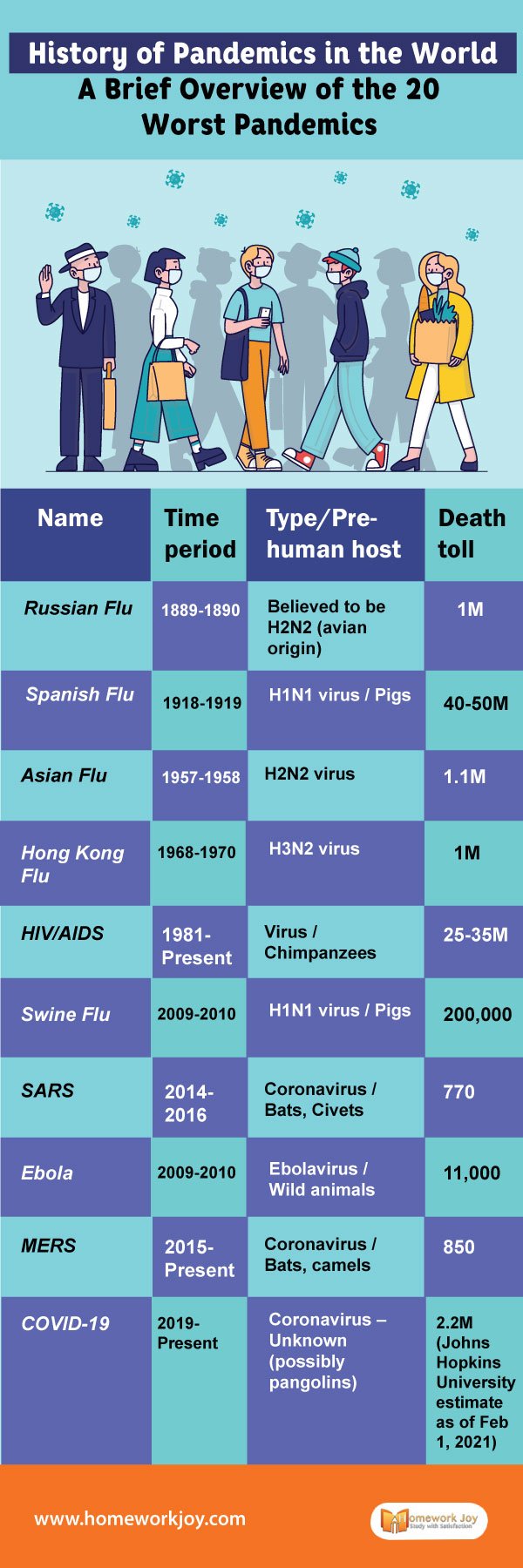Our planet earth has a long history of pandemics. Be it SARS, MERS, HIV/AIDS, or the most recent, COVID-19 (Coronavirus). Time and again, various kinds of viruses spread in the world, taking the lives of many. Firstly, let’s know what is a pandemic.
A pandemic is an epidemic that occurs on a broad scale, crossing international boundaries and usually affecting people worldwide.
Antonine Plague
The Antonine Plague, also known as the Plague of Gelen, erupted in 165 CE and affected the entire Roman Empire. The common symptoms were fever, diarrhea, vomiting, thirstiness, swollen throat, and coughing.
Black death
Black death ravaged Europe between 1347-1351. The black end is a result of the plague caused by the infection of the bacterium Yersinia pestis.
Plague of Justinian
The plague of Justinian spread during the reign of Emperor Justinian. It was the beginning of one of the first plague pandemic.
Cholera pandemic
The cholera pandemic was the first Asian cholera pandemic, and it began in Calcutta. The cholera pandemic spread across Asia and Europe, killing thousands of people.
Yellow fever
Yellow fever is spread through a species of mosquito common to areas of Africa and South America. The symptoms include fever, headache, nausea, and vomiting. Severe cases may cause fatal heart, liver, and kidney conditions. No treatment for the disease exists.
SARS
SARS ( Severe Acute Respiratory Syndrome) is a respiratory disease caused by a SARS-associated coronavirus. The virus was identified at the end of February 2003 during an outbreak that emerged in China and spread to 4 other countries. SARS is an airborne virus and can spread through small droplets of saliva similar to the cold and influenza.
HIV/AIDS
HIV, also known as (human immunodeficiency virus) is a virus that attacks cells that help the body fight infection, making a person more vulnerable to other infections and diseases. There is no treatment for HIV, and no cure exists as of now, so if an individual has HIV, then it’s for life. In contrast, AIDS is the late stage of HIV that occurs when the body’s immune system is severely damaged because of the virus.
Swine Flu
Swine flu is a virus that usually infects pigs and is caused by a strain of influenza virus. The symptoms of swine flu consist of fever, chills, sore throat, cough, nausea, and vomiting, etc.
Ebola Virus
Ebola virus can cause severe bleeding, organ failure and can even lead to death. The Ebola virus is transmitted to people from animals and spreads in the human population through the human transmission.
Coronavirus (COVID-19)
Coronavirus is a newly discovered virus, and its symptoms include fever, cough, sore throat, shortness of breath, etc. The virus can lead to pneumonia, heart problems, liver problems, and even death.
For more such articles, visit Homework Joy.
